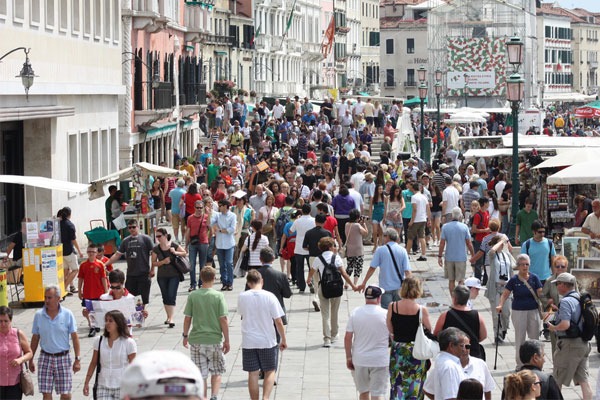Venice introduces entry fee for day visitors to curb over-tourism and preserve cultural heritage

Venice introduces entry fee for day visitors to curb over-tourism and preserve cultural heritage
Venice takes an Initiative to preserve its heritage amidst Over-Tourism and Over-Crowding in its beautiful city lanes, by introducing an entry ticket fee for day travellers
In the heart of Italy’s Veneto region lies a city spread over 100 small islands that need no introduction: Venice, a timeless gem adored by travellers from every corner of the globe. Its intricate labyrinth-like canals, historic architecture, and romantic ambience have long captivated the imaginations of poets, artists, and wanderers alike. Yet, beneath its picturesque front, Venice is grappling with a modern-day dilemma: Over-Tourism.
For years, the city has struggled to balance the influx of visitors with the preservation of its culture and the well-being of its residents. The sheer magnitude of tourists flooding its narrow streets and historic sites has posed a heap of challenges, from straining the city’s infrastructure to eroding the very fabric of Venetian life. Venice is also one of the world’s top tourist destinations, with about 3.2 million visitors gracing the Historic Centre whereas. The resident population has dwarfed to just 50,000.
It is not only the structures, but the culture being flooded with mass attention and subtle appropriations also start taking place. In response, the city has embarked on an innovative initiative based on a lot of ideation and mind—one that may revolutionize the way destinations worldwide address the perils of over-tourism.
Effective April 23rd, 2024, Venice has implemented a day-trip entry fee, marking a monumental shift in its approach to tourism management, it shall set a precedent. This daring move, the first of its kind globally, aims to curb the adverse effects of mass tourism and overcrowding in sites of historical or cultural value while promoting sustainable travel practices.
Under the new system, day visitors will be required to purchase a five-euro ticket—a modest fee with significant implications for the city’s future to come. At its core, the entry fee seeks to alleviate the strain on Venice’s historic centre, which plays host to millions of tourists each year. By incentivizing visitors to choose quieter periods of time, and take up various other activities as well for their explorations, the city hopes to mitigate overcrowding and preserve the integrity of its cultural treasures. This strategic approach reflects a nuanced understanding of the delicate balance between tourism and heritage conservation to protect heritage from any physical or cultural harm—a balance that Venice is determined to uphold.
Mayor Luigi Brugnaro, the architect of this visionary initiative, frames it as an “experiment” in enhancing Venice’s liveability rather than simply restricting access. His commitment to striking a harmonious balance between tourism and local life underscores the city’s progressive mindset. With an eye toward inclusivity, the fee exempts certain groups, such as hotel guests, minors, and the disabled, ensuring that accessibility remains a cornerstone of Venice’s hospitality. But Venice’s journey toward sustainable tourism is not without its challenges.
The decision to impose an entry fee was not taken lightly, amid concerns over potential economic repercussions and objections from various quarters. However, the city’s resolve to address the root causes of over-tourism prevailed, guided by a shared commitment to safeguarding its heritage for generations to come. The urgency of Venice’s actions draws attention to the forthcoming vision of UNESCO’s warnings being true. The UN’s cultural body UNESCO had listed the city and its lagoons as a world heritage site in 1987, deeming it to be an “extraordinary architectural masterpiece”. The UN cultural body has long cautioned against the perils of mass tourism and rising sea levels, which threaten to engulf Venice’s architectural splendour. In response, the city has embraced innovation as a means of adaptation, leveraging all technology and policy formulation to forge a sustainable path forward for itself, and its citizens in the global community.
Central to this endeavour is the principle of responsible tourism—a paradigm shift that goes beyond mere visitor numbers to incorporate a holistic approach to travel. By fostering a culture of respect and stewardship among tourists and residents alike, Venice aspires to redefine its identity as a beacon of excellence in sustainable tourism. As the world looks to Venice for leadership in navigating the complexities of over-tourism, the city stands at a crossroads—a vessel of innovation and tradition, where the past converges with the future. In the rippling waters of its canals and the timeless beauty of its palaces, Venice reminds us of the fragility and resilience of our shared cultural heritage. And in its steadfast commitment to preserving that heritage, Venice offers a glimpse of hope—a testament to the transformative power of collective action in safeguarding the treasures of our world.
For the first time, day visitors will have to buy a five-euro ticket, monitored by inspectors, and watch guards, carrying out checks at all key points and spots in the UNESCO World Heritage sites of the city. There won’t be any physical barriers for ticketing areas of control. Fines for non-compliance to the ticketing system range from 50 to 300 euros, with exemptions for hotel guests, minors who are under 14 years of age, and the disabled. For the time being, there is no ceiling on the number of tickets yet and they can be downloaded in the form of a QR code from a website (https://cda.ve.it/en/) and be distributed each day, just a click away!









